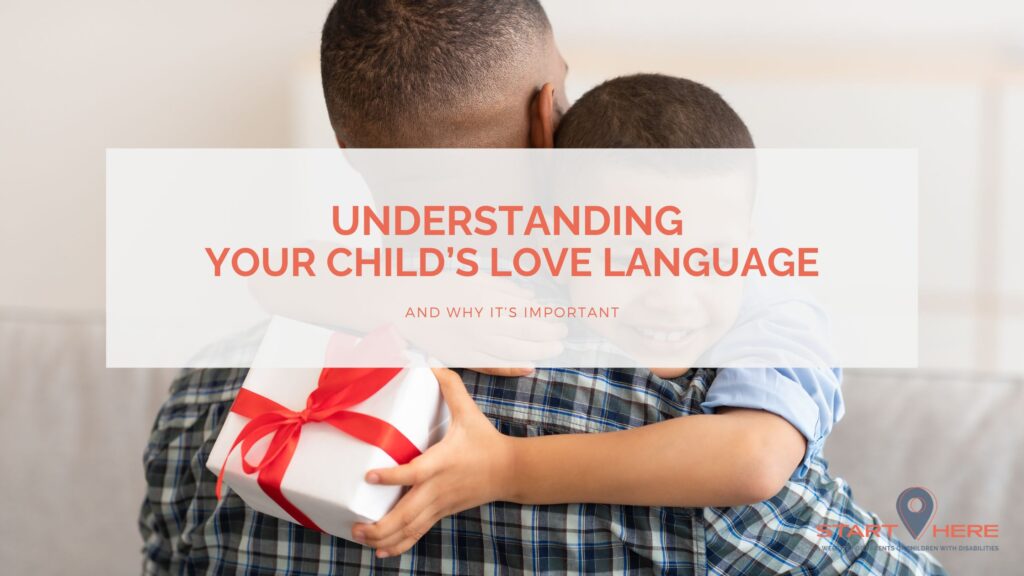
We are all comfortable giving and receiving love in different ways. You might be familiar with the 5 ‘love languages’ as coined by Dr. Gary Chapman as an explanation of the ways romantic partners express and experience love.
There are all kinds of resources to identify your love language; from quizzes to books and even TED talks. The theory is that we all express and experience love in the same 5 ways, but everyone has preferred ways of receiving love -and default ways of showing love. Some people feel that understanding the love languages and having dialogue about them is the secret to lasting relationships. The way that we show care for our children is just as important as any other kind of caring partnership. We don’t see any reason why children would be less likely to have a particular way they feel most loved and cared for which is why we explored the 5 love languages and how they relate to the relationships between parents and children.
First, what are the 5 love languages?
- Acts of service – expressing love through helpful actions.
- Physical touch – demonstrating love through physical gestures.
- Quality time – building connection through dedicated time together
- Receiving gifts – demonstrating love through gifts that show you were thinking of them (with the sentiment being more important than the actual thing you are giving)
- Words of affirmation- showing love through verbal praise and acknowledgement
Understanding your child’s love language will guide you on how to love your child in a way that they can understand and receive.
**You’ll want to lavish your child with all the love languages until they are able to express or clearly indicate what their preferences are.**

How to discover your child’s primary love language?
The best way is to observe how your child expresses their love to you and to other’s that they care about. This is something you can start observing from a very young age. Children are likely to show their affection in the way they want to receive it. As an adult you know that we should offer love to people in the ways that they feel love the deepest but kids do not generally understand that concept and will offer love in the ways that they crave it.
Pay attention to your children’s expressions of care. Do they grab your leg and beg for kisses when you come home? Do they hand you their toys as a sign of caring and sharing? Do they compliment your outfits and personality? They are likely wanting the same back!

Examples of your child’s love language:
Acts of Service
Does your child beg you to read to them? To zip their coat, tuck them in, tie their shoes, fill up their water bottle, bring them things or to help them pack? It might make you feel a bit like their personal assistant, and some children will ask so they don’t have to do things themselves, but these could be requests to feel loved. There are chores that can be your child’s responsibilities, but fulfilling some simple requests might help your child feel cared for by you.
Physical Touch
Children who express their love through physical touch might enjoy hugging, holding hands, or cuddling. When a child wraps their arms around you or climbs into your lap, they are conveying their affection and security. They might also use touch to comfort you or seek comfort themselves, such as resting their head on your shoulder when they’re feeling tired or upset. These gestures are their way of communicating love and trust, providing reassurance and a sense of closeness. Physical touch is a powerful and direct form of expression for young children, reflecting their emotional bonds and their desire for connection.
Quality Time
If your child’s primary love language is quality time, they thrive on undivided attention and meaningful interactions. When a child shows love through quality time, they are expressing their affection by seeking and valuing meaningful interactions with you. This might look like initiating play, wanting you to join activities they are looking forward to, or inviting you to plans that did not initially include you. Understanding that a child’s love language is quality time helps caregivers focus on creating meaningful, uninterrupted moments that foster a strong emotional bond and meet the child’s needs for affection and connection.
Receiving Gifts
If a child’s love language is receiving gifts, they often express their affection and appreciation through their response to gifts and by valuing thoughtful gestures. They may give you homemade gifts, show their appreciation by talking about the exciting gifts they have received in the past / preparing a heartfelt thank you or putting effort into personalizing gifts for you.
Words of Affirmation
If a child’s love language is words of affirmation, they will likely express their affection and appreciation through verbal encouragement and positive reinforcement. They might frequently offer compliments, praise, and encouraging words to those they care about, such as telling you how much they love you or expressing pride in your achievements. They may also be quick to offer kind words and support to friends and family, recognizing and affirming others’ strengths and efforts. This verbal expression of love and appreciation helps them feel connected and valued, and they naturally extend this practice to those around them, reinforcing their relationships through heartfelt and affirming communication.
‘Mommy, you look so pretty in that dress?’
‘Daddy, I love you THIS MUCH!’
‘Thank you for helping me!’

Ways to positively connect with your child based on their love language and the actions to avoid:
Acts of Service
+ making exceptions to a general rule to show love
+ prepare their favorite meal
+ read to them
+ offer to sit and help them with schoolwork, project or craft they are working on
+ offer proactively to play with them
+ organize a special outing that includes their interests
+ prepare a surprise
+ prepare them a cozy space
(-) overscheduling
(-) putting the focus center around your interests instead of theirs
(-) forcing activities
(-) doing the chores they are expected to do for them
As children grow, it’s crucial to foster their self-reliance and encourage them to handle tasks appropriate for their developmental stage. Dr. Chapman emphasizes that the most valuable act of service is guiding your child through new processes and teaching them, step-by-step, to become more capable.
Dr. Chapman advises against responding to every request immediately. Instead, offer thoughtful responses, even if that means occasionally saying no. Be mindful of how often exceptions to rules occur. For instance, if you find yourself frequently picking up your child’s dirty clothes or emptying their lunchbox, it’s important to pause and reassess your approach.
Physical Touch
+ hugs
+ holding hands
+ cuddling
+ back rubs
+ tickling
+ hair ruffling
+ shoulder pats, rests or squeezes
+ piggy back rides
+ holding them close
+ pats on the back
+ rocking
These physical touches are simple yet powerful ways to convey your love and strengthen your bond with your child.
When physical touch is a child’s primary love language, it’s crucial to be mindful of how touch is used to avoid any negative impact. Here are some examples of physical touch that could be harmful or counterproductive:
(-) forceful or aggressive touch
(-) touch that ignores their boundaries or doesn’t stop whey they ask for space
(-) punitive
(-) inconsistent, such as only touching them when you are trying to make up for something you did wrong as this will could make them feel uncertain about affection
(-) unresponsive, brushing off their attempts at physical touch
Understanding and respecting a child’s preferences and boundaries regarding physical touch is essential to maintaining a positive and supportive relationship.
Hitting or physical aggression can severely damage young children’s development by instilling fear, eroding their sense of safety, and disrupting their ability to form trusting and healthy relationships.
Quality Time
An important note about quality time is the significance of quality over quantity: it’s not just about the amount of time spent, but the quality of that time. They appreciate when you are fully present, attentive, and engaged during your interactions.
+ one on one conversations where you are actively listening and responding
+ playing together
+ special outings
+ offering to help them with something (homework, projects, etc.)
+ cooking or baking
+ including them in something you would normally do alone
+ family rituals like dinnertime, movie night or weekend adventures
+ listening to music or dancing together
(-) ignoring requests for attention
(-) being distracted (on phone or texting) when spending time together
(-) breaking promises
(-) rushing through interactions
(-) missing out
(-) using time as a bargaining chip or punishment
(-) failing to participate in their interests
Receiving Gifts
+ personalizing gifts that reflect their individual interests, hobbies or passions
+ surprise gifts
+ handmade gifts
+ thoughtful tokens
+ regular gestures (such as a new book at bedtime)
+ involve them in choosing gifts for others
+ personalized notes
+ crafting gifts together
+ donating to organizations together
Showing love through gifts doesn’t have to be extravagant or expensive; it’s the thoughtfulness and understanding of their love language that counts the most.
(-) inconsistent gift giving, failing to acknowledge a special occasion or not following through on a promised gift
(-) impersonal gifts
(-) gifts being used as a bargaining tool or with conditions
(-) neglecting their interests with gifts that don’t align can make them feel misunderstood or unappreciated
(-) overemphasis on materialism
(-) lack of quality time alongside gift giving can make the gifts feel hollow
Words of Affirmation
+ offer praise
+ express affection
+ encourage them
+ celebrate their efforts
+ write notes
+ give compliments
+ listen actively
+ share affirming stories
+ acknowledge their feelings
+ share special moments
(-) lack of praise
(-) negative or criticizing comments
(-) ignoring their achievements or goals
(-) inconsistent affirmation
(-) unkind words
(-) failure to validate their feelings
(-) overlooking their needs for encouragement
(-) comparing them to others
(-) failing to communicate love verbally and consistently
Understanding and honoring your young child’s love language is essential for nurturing their emotional well-being and fostering a strong, supportive relationship. For children with disabilities, this approach is even more crucial as it helps bridge communication gaps and meets their unique needs in meaningful ways. Whether their love language is physical touch, quality time, acts of service, gifts, or words of affirmation, being attentive to how they express and receive love allows you to create a nurturing environment that resonates with their individual experiences and preferences.
By identifying and embracing your child’s love language, you can offer them a sense of security and validation that is vital for their development. Tailoring your expressions of love to their preferred language not only strengthens your bond but also helps them feel understood and valued. Remember, it’s about quality and sincerity—genuine efforts to connect with them in their own way can make a world of difference. As you navigate this journey, your attentiveness and commitment will provide them with a foundation of love and support that can profoundly impact their growth and happiness.

